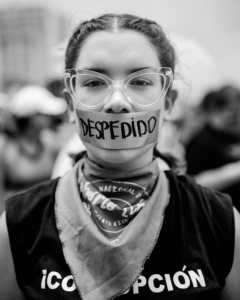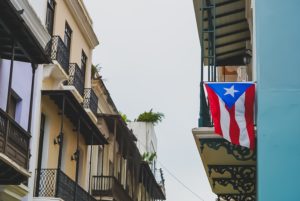Puerto Rico, Youth, & the Power of Protest
go.ncsu.edu/readext?635939
en Español / em Português
El inglés es el idioma de control de esta página. En la medida en que haya algún conflicto entre la traducción al inglés y la traducción, el inglés prevalece.
Al hacer clic en el enlace de traducción se activa un servicio de traducción gratuito para convertir la página al español. Al igual que con cualquier traducción por Internet, la conversión no es sensible al contexto y puede que no traduzca el texto en su significado original. NC State Extension no garantiza la exactitud del texto traducido. Por favor, tenga en cuenta que algunas aplicaciones y/o servicios pueden no funcionar como se espera cuando se traducen.
Português
Inglês é o idioma de controle desta página. Na medida que haja algum conflito entre o texto original em Inglês e a tradução, o Inglês prevalece.
Ao clicar no link de tradução, um serviço gratuito de tradução será ativado para converter a página para o Português. Como em qualquer tradução pela internet, a conversão não é sensivel ao contexto e pode não ocorrer a tradução para o significado orginal. O serviço de Extensão da Carolina do Norte (NC State Extension) não garante a exatidão do texto traduzido. Por favor, observe que algumas funções ou serviços podem não funcionar como esperado após a tradução.
English
English is the controlling language of this page. To the extent there is any conflict between the English text and the translation, English controls.
Clicking on the translation link activates a free translation service to convert the page to Spanish. As with any Internet translation, the conversion is not context-sensitive and may not translate the text to its original meaning. NC State Extension does not guarantee the accuracy of the translated text. Please note that some applications and/or services may not function as expected when translated.
Collapse ▲Written by: Maru Gonzalez, Sam Chan, Nyawira Nyota, & Luke Shealy
Note: This piece was originally published on Latino Rebels and can be found here – Puerto Rico Youth Protest.
Though still not over, it’s fair to say that 2019 has been the year of the protest. From Chile and Ecuador to Catalonia, Hong Kong, and Lebanon, citizens have taken to the streets in mass numbers to hold their elected officials accountable and call for change. This year has also brought climate justice to the fore, with global protests taking place across more than 150 countries. And while each protest has been driven by a distinct cause, young people have played a central role in mobilizing bodies, raising awareness, and demanding action.
Young people’s voices were front and center in July of 2019, when Puerto Rico erupted into twelve straight days of protests as citizens demanded the resignation of Governor Ricardo Rosselló. This call was fueled by corruption within the government, inaction after Hurricane María, and the mounting debt crisis.
The final straw came after the discovery of nearly 900 pages of misogynistic and homophobic text messages exchanged between the governor and members of his administration. The people of Puerto Rico decided enough was enough. And after years of government inaction, they knew that change would not come without a fight. Determined, they took to the streets in mass numbers, the likes of which the island had never seen.
And while the protests were intergenerational, the majority of participants — and those leading organizing efforts — were under 30. That’s because, as Puerto Rican youth activist Aliana Alcoba contends, apathy is not an option: “Most young Puerto Ricans want to stay on the island. They want a better Puerto Rico for their future and for their children so…I think that’s why young people were so encouraged.”
According to Aliana, young people, whether in Puerto Rico or other parts of the world, need to stop underestimating themselves: “We’re young but we’re very smart. We’re very aware. We’re very conscious. We have social media. We have the internet. We have access to so much information that people didn’t have before, so we need to use that in a way…that creates real change…because it’s our future and we have the right to fight for a better future.”
The youth-led protests in Puerto Rico demonstrated what is possible when citizens stand united in their call for change. As Aliana described, “There was a sense of solidarity at the protests. They weren’t led by a single person or organization.”
Across the island — from the restaurant owner providing free food to protesters to the young people mobilizing in large numbers and to those donating water or coordinating transportation — Puerto Ricans put partisan differences aside and helped one another, united by a fierce love for their island and a commitment to restore power to the people. This spirit of community, according to Aliana, was key to the success of the protests.
Social media also played a significant role in coordinating logistics and increasing turnout. It served as a powerful grassroots tool for organizing transportation, news updates, necessary supplies, and safe meeting locations while simultaneously putting pressure on Rosselló to resign. As Aliana explained, #RickyRenuncia, trending on Twitter throughout the protests, helped shine a spotlight on Puerto Rico and brought more people and additional media attention to the streets, amplifying the call for Rosselló’s resignation and ultimately bringing the administration to its knees.
By all accounts, the protests in Puerto Rico were a success. Over twelve days of persistent, peaceful, and unified demonstrations, the people of Puerto Rico — and youth in particular — showed the rest of the world what democracy, solidarity, and civic engagement look like.
As people across the globe continue to take to the streets to demand change, Puerto Rico should serve as a beacon of hope, a case study on the promise of an informed and united citizenry, and a lesson on the power of protest.
To hear more from Aliana and learn more about young people’s role in Puerto Rico’s protests, check out the episode, “Puerto Rico and the Power of Protest,” available on Stitcher.
Questions for Extended Dialogue:
|




